Hexagon
A hexagon is a polygon with 6 sides and 6 corners (vertices). Like regular triangles and squares, hexagons fit together without gaps. This is known as a tessellation. Because of this, they are often used for tiling floors. They are also quite common in nature. For example, the honeycombs in a beehive are hexagons.
| Regular hexagon | |
|---|---|
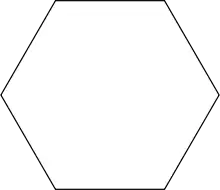 A regular hexagon | |
| Type | Regular polygon |
| Edges and vertices | 6 |
| Schläfli symbol | {6}, t{3} |
| Coxeter diagram | |
| Symmetry group | Dihedral (D6), order 2×6 |
| Internal angle (degrees) | 120° |
| Dual polygon | Self |
| Properties | Convex, cyclic, equilateral, isogonal, isotoxal |
Hexagons: in nature and by humankind
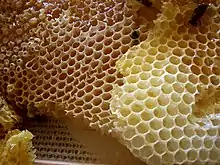 A beehive honeycomb
A beehive honeycomb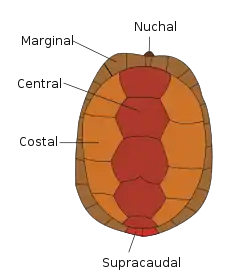
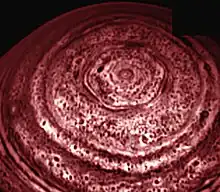 North polar hexagonal cloud feature on Saturn, discovered by Voyager 1 and confirmed in 2006 by Cassini Archived 2010-02-16 at the Wayback Machine Archived 2010-09-27 at the Wayback Machine
North polar hexagonal cloud feature on Saturn, discovered by Voyager 1 and confirmed in 2006 by Cassini Archived 2010-02-16 at the Wayback Machine Archived 2010-09-27 at the Wayback Machine Micrograph of a snowflake
Micrograph of a snowflake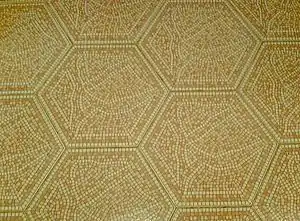 Hexagonal floor tessellations (in Rome)
Hexagonal floor tessellations (in Rome)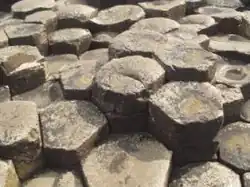 Naturally formed basalt columns from Giant's Causeway in Ireland; large masses must cool slowly to form a polygonal fracture pattern
Naturally formed basalt columns from Giant's Causeway in Ireland; large masses must cool slowly to form a polygonal fracture pattern An aerial view of Fort Jefferson in Dry Tortugas National Park
An aerial view of Fort Jefferson in Dry Tortugas National Park
Other websites
- Definition and properties of a hexagon With interactive animation
- Cassini Images Bizarre Hexagon on Saturn Archived 2010-09-27 at the Wayback Machine
- Saturn's Strange Hexagon Archived 2010-02-16 at the Wayback Machine
- A hexagonal feature around Saturn's North Pole
- "Bizarre Hexagon Spotted on Saturn" - from Space.com (27 March 2007)
This article is issued from Wikipedia. The text is licensed under Creative Commons - Attribution - Sharealike. Additional terms may apply for the media files.
